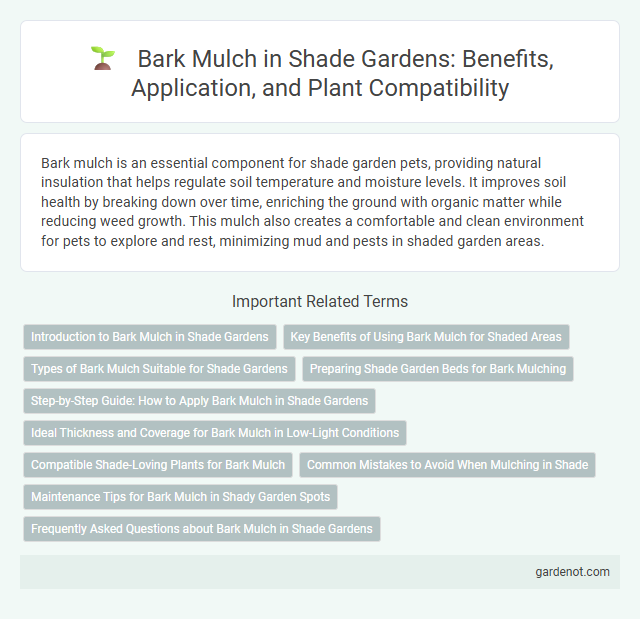Bark mulch is an essential component for shade garden pets, providing natural insulation that helps regulate soil temperature and moisture levels. It improves soil health by breaking down over time, enriching the ground with organic matter while reducing weed growth. This mulch also creates a comfortable and clean environment for pets to explore and rest, minimizing mud and pests in shaded garden areas.
Introduction to Bark Mulch in Shade Gardens
Bark mulch is an essential organic ground cover that helps retain moisture and regulate soil temperature in shade gardens. Its coarse texture improves aeration while suppressing weed growth, creating a healthier root environment for shade-loving plants. Rich in nutrients, bark mulch gradually decomposes, enhancing soil fertility and supporting plant growth.
Key Benefits of Using Bark Mulch for Shaded Areas
Bark mulch helps retain soil moisture, making it ideal for shaded garden areas where water evaporation is slower. It suppresses weed growth and regulates soil temperature, promoting healthier root development in shade-tolerant plants. Organic bark mulch also gradually decomposes, enriching soil nutrients and enhancing soil structure over time.
Types of Bark Mulch Suitable for Shade Gardens
Cedar bark mulch and hemlock bark mulch are ideal for shade gardens due to their moisture retention properties and natural resistance to decay. Pine bark mulch provides excellent aeration and prevents soil compaction, supporting healthy root growth in low-light areas. Fir bark mulch decomposes slowly, enriching soil nutrients while maintaining consistent soil temperature under dense tree canopies.
Preparing Shade Garden Beds for Bark Mulching
Preparing shade garden beds for bark mulching involves first clearing the area of weeds and debris to ensure mulch effectiveness. The soil should be lightly loosened and amended with organic matter to promote moisture retention and root health under low-light conditions. Applying a 2-3 inch layer of bark mulch helps regulate soil temperature and suppress weed growth, creating an ideal environment for shade-loving plants.
Step-by-Step Guide: How to Apply Bark Mulch in Shade Gardens
To apply bark mulch in shade gardens, start by clearing the area of weeds and debris, then level the soil to ensure even coverage. Spread a 2 to 3-inch layer of bark mulch around shade-tolerant plants, taking care to keep it a few inches away from plant stems to prevent rot. Regularly replenish the mulch layer every year to maintain moisture retention and temperature regulation in shaded areas.
Ideal Thickness and Coverage for Bark Mulch in Low-Light Conditions
Bark mulch in shade gardens should be applied at an ideal thickness of 2 to 3 inches to maintain soil moisture and regulate temperature effectively in low-light conditions. Proper coverage ensures suppression of weed growth while allowing adequate air and water penetration to the roots. Using bark mulch at this depth promotes healthy plant growth by improving soil structure and nutrient retention in shaded environments.
Compatible Shade-Loving Plants for Bark Mulch
Bark mulch enhances moisture retention and temperature regulation, making it ideal for shade-loving plants such as ferns, hostas, and astilbes, which thrive in cool, damp environments. It also supports the growth of shade-tolerant groundcovers like ivy, pachysandra, and vinca minor by suppressing weeds and providing a nutrient-rich layer. Selecting compatible plants ensures optimal soil health and sustained hydration crucial for lush, vibrant shade gardens.
Common Mistakes to Avoid When Mulching in Shade
Applying bark mulch too thickly in a shade garden can suffocate plant roots and retain excess moisture, leading to root rot and fungal diseases. Using mulch with large wood chunks may create air gaps that reduce soil contact, hindering moisture absorption in shaded areas. Avoid piling mulch directly against tree trunks or stems, as this can attract pests and cause bark decay in low-light environments.
Maintenance Tips for Bark Mulch in Shady Garden Spots
Regularly check bark mulch in shady garden spots for moisture retention to prevent mold growth and fungal issues. Rake and aerate the mulch to maintain airflow, which helps reduce decay and keeps the soil healthy. Replenish mulch annually with a 2-3 inch layer to suppress weeds and regulate soil temperature in low-light environments.
Frequently Asked Questions about Bark Mulch in Shade Gardens
Bark mulch in shade gardens helps retain soil moisture, suppress weeds, and regulate temperature, making it ideal for shaded environments with limited sunlight. Common questions address the best types of bark mulch for shade, such as cedar or fir, and concerns about acidity levels affecting soil pH and plant health. Proper application involves spreading a 2-3 inch layer around trees and plants, avoiding direct contact with stems to prevent rot and pest issues.
Bark mulch Infographic

 gardenot.com
gardenot.com